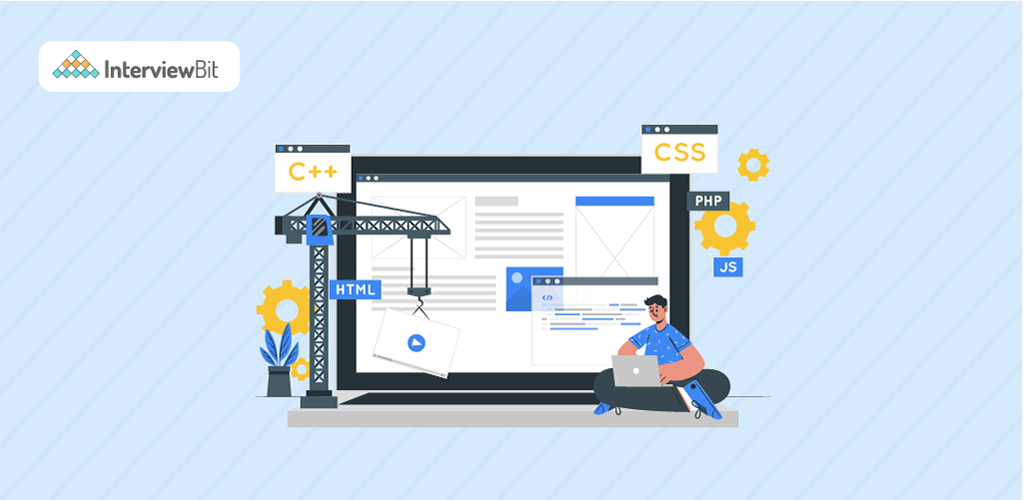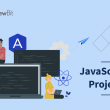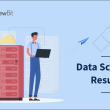Are you wondering what to do to become a great full-stack developer?
Then this article is right on point for you.
The gap of being something to be great at something is bridged by your determination towards upskilling yourself. Learning different skills in your career not only helps you to stand out from the crowd but also accelerates your cognitive and behavioral capabilities.
- It broadens your perspective.
- It strengthens your confidence.
- It impacts your analytical skills towards complex issues.
- It brings out a communicative leader in you.
And so much more. There is no doubt that the position of a full-stack developer allows for a much bigger scope to upskill oneself because of its multitudinous role.
Confused about your next job?
To get to know what is a full-stack developer and what are the top 10 skills required to be a great one, keep reading the article.
What is a full-stack developer?
When the word full-stack developer comes to mind, one employer always expects a person who has mastery over comprehensive technical solutions. In simple terms, a full-stack developer is a professional who understands and masters the front-end (client-side), back-end (server-side), and databases of the web application.
However, in order to clearly understand what a full stack developer is, you need to be well-versed with the elements of web development i.e. the user interface (front-end) and the server-side (back-end).
A website or web application’s functionality depends on two main elements known as the front end and the backend.
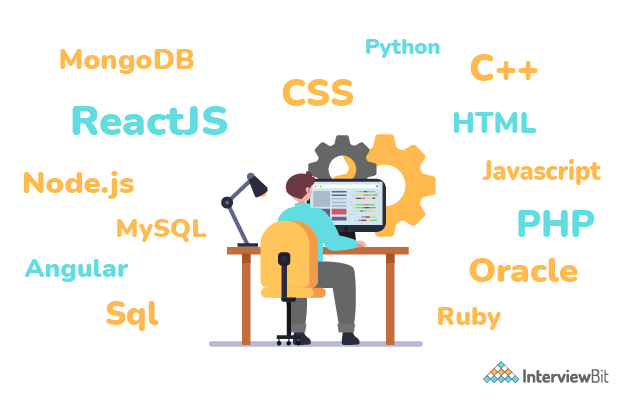
What is Front-End Development?
Front-end development, also known as client-side development is the element of the website that a user can see or interact with. This element gives one’s website or application visual functionality.
For example, if you plan on making a website for your business some photos and content will not make up your website. You will need to give them selection criteria, a track for the client’s info, your location, contact details, etc.
Front-end development is what makes these functions appear to the user on the application.
What is Back-End Development?
Backend Development, also known as server-side development is the element that is not visible to the clients. The core functionality of a back-end development lies in the fact of making the interaction of the user with the application smooth and hassle-free. In addition to this, it is responsible for maintaining and organizing databases and behind-the-scenes functionality of the front end as well.
Suppose, coming on to your website many users fill out the contact form and make a purchase. In return, all they see is a front-end code of the successful transaction. But backend development is responsible for completing the purchase and storing the information in the database.
For a dynamic and functional website, you need back-end development.
Accordingly, some developers are proficient in not a single side of development and rather are interested in both sides (front-end and back-end) of working. These developers are called full-stack developers.
Difference Between Full-Stack Developer & Software Engineer
When one enters the realm of web development, the roles kind of overlap with one another. For this purpose, you need to steer clear of your choice of role and responsibilities.
People often interchange the term developer and engineer wherein there is a certain level of difference in both of these roles.
Let us see the clear difference between the two.
Full-stack Developer
A full-stack developer is an expert who handles the client side as well as the server side of the web applications. They are a part of the development team that works on all the steps of the web application. They not only maintain the databases, design, and handle backend operations of the application, but ensure an error-free development testing and deploying the application as well.
Their role is multifaceted, they have knowledge of both elements (front-end and back-end) of web applications and hence are quite in demand in present years. Because of their varied skill-set, they could step in on any part of the application process and assist their team members if faced with any complex issue.
Software Engineer
A software engineer is a broad term for a person with technical expertise not just in the field of software development His/Her role is not limited to working on just the SDLC (software development life cycle) inclusive of designing to development testing but, also work with clients and other team members for analyzing and directing our existing programming projects.
They are a part of the Engineering team that works with development elements like databases, front-end, and back-end and also manages existing systems, and platforms by providing scalable solutions for the betterment of the company. This makes a full-stack developer a part of the software engineer.
So, a software engineer can include people who work on different elements of the applications like designing, architecture, and development testing as well as for different platforms like desktop or web whereas, a full-stack developer who is a part of the software development team works on specific elements like front-end and back-end of the application.
Software engineers require a Computer Science degree and extensive knowledge of different programming languages like Java, Swift, C, and C++ to work efficiently on different applications.
Top 10 Full-Stack Developer Skills
A full-stack developer as aforementioned is not a multifaceted role. To excel at this role one requisite, is not just a formal degree instead, extensive knowledge of a variety of skills. Diversity is the key to excellence and success in the profession of a full-stack developer.
Below are mentioned full-stack developer skills that will help you outshine in this position.
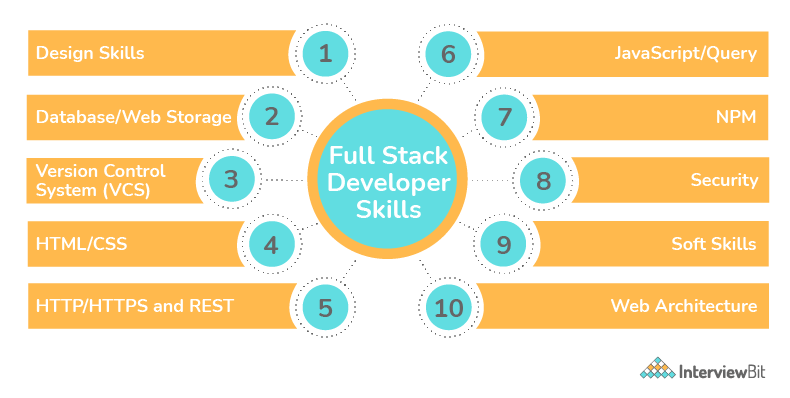
1. HTML and CSS
Hypertext Markup Language or HTML is a language for front-end technologies. It is used by developers to administer the format and visuals of text and images on the website. It manages the structure of the webpage into the hierarchy of headings, paragraphs, body, pop-ups and so much more.
Cascading Sheet Styles or CSS is a style language that allows you to style and alter the HTML elements. Suppose, you want to give different colors to your heading and paras, do it with the effective personalization tool of CSS.
A full-stack developer should know how to work with these two core personalized frontend tools in order to work well with the client side of the application. These languages will assist in enhancing the interaction and visuals of the web application for the users.
2. JavaScript
Whenever full-stack developer skills are being discussed one cannot leave behind JavaScript. It is one of the dynamic languages used by developers for interactive and enhanced front-end development. However, because of its dynamic nature, it could be used for the client-side as well as the server-side development.
JavaScript with its complete integration with HTML, CSS, and adaptability with significant browsers make the work of developers quite simple and efficient.
Besides these many frameworks are also there for front-end development like Angular, React, React Native and Vue, etc.
A full-stack developer should have a fundamental knowledge of JavaScript plus, be cognizant of the added libraries or new frameworks in this language for constant growth. To excel, a full-stack developer should be aware of all the capabilities of JavaScript.
3. Git and GitHub
Web Development seems a little incomplete without the presence of the infamous Git and GitHub. It is known to amateurs developers to experienced ones.
Git, a “distributed version control system” for developers allows them to handle every small step of the development process. It stands out from the other control systems because of its efficiency in error-solving and tracking. You can keep a track of your progress, make changes, add ‘snapshots’ of it, go back and make necessary modifications and much more.
GitHub is a platform that allows developers to work, manage, and review simultaneously on many projects. As the name suggests, it creates a hub for networking and interacting with other developers. GitHub uses git features to provide a perfect platform for developers.
A full-stack developer learning the working of such platforms allows for imbibing team management skills, leadership and cooperation. In addition, it will increase a developer’s ability to work efficiently as such platforms make working on codes easy and effective.
4. BackEnd Development Languages
As a full-stack developer works on both the front-end and back-end, he/she should have a fundamental understanding of technical backend programming languages as well.
To name a few languages requisite for backend development are as follows:
- Python: With frameworks including Django and Flask, Python is among the commonly used programming languages for backend development. The simplified syntax and varied features allow it to be used for multiple high-level object-oriented and structured programming.
- Java: It is an innovative ‘class-based’ programming language that is used for not just web application development but for mobile applications and desktop applications as well. This makes it a multipurpose programming language for developers.
- PHP: A compatible programming language that is fast, resilient, and efficient. With its features available for server-side scripting and adaptability on different operating systems like macOS, Unix, and Windows, it is one of the most used programming languages for backend development.
- Ruby: It is a programming language that is used for both backend and web application development. This language is known for its simplified code, dynamic typing, and object-oriented principles. Unlike many other languages, Ruby has a number of approaches to solving a problem while coding. To make the work of developers more efficient, Ruby created an open-source framework known as Ruby on Rails. Rails web is one of the most popular frameworks for back-end development amongst developers.
These languages will assist the full-stack developers in making them all the more proficient and better in their roles.
5. Web Architecture
A full-stack developer needs to upskill him/herself in order to maintain his/her proficient responsibility. And to excel in this, one needs to have a basic knowledge of web architecture.
Being the expert in many elements, the team expects a full-stack developer to know about the structural elements and user interface elements of the web application like DNS or Domain Name System, Database Servers, Cloud Storage and so much more.
6. Database Management Systems
To be an experienced and exemplary full-stack developer, you should know everything about database management systems.
As a part of the development team, there is a need for a perfect system to manage all the databases. For this, besides the programming languages, you should be well-versed with systems like Oracle, MySQL, SQLite, Microsoft Access, etc.
7. Fundamentals of Designs
It is often said that a development team is differentiated from a design team. It is true, however, as a diversified role a full-stack developer should have the basic knowledge of designing to make the front-end development more appealing and interactive.
This skill will help you understand user psychology while developing the client side of the application.
8. REST and SOAP
As a full-stack developer bridge, the gap between the two most important elements of web application development, communication between the two is highly required. To consider this role, a full-stack developer should have proficiency in working with web services or application program interfaces (APIs) like REST and SOAP.
These two web services will allow you to share data between two different systems thereby making operations efficient and productive.
9. Technology Stacks
A full-stack developer should be well-versed with all the technologies and keep upgrading himself according to the role and responsibility. Different companies have different preferences and hence, there is a need for you to be aware of the popular stacks to create a web application.
Some of the preferred stacks are LAMP stack, Django stack, etc. Accordingly, be informed of the difference in their working and all the layers while working on an application.
10. Soft Skills
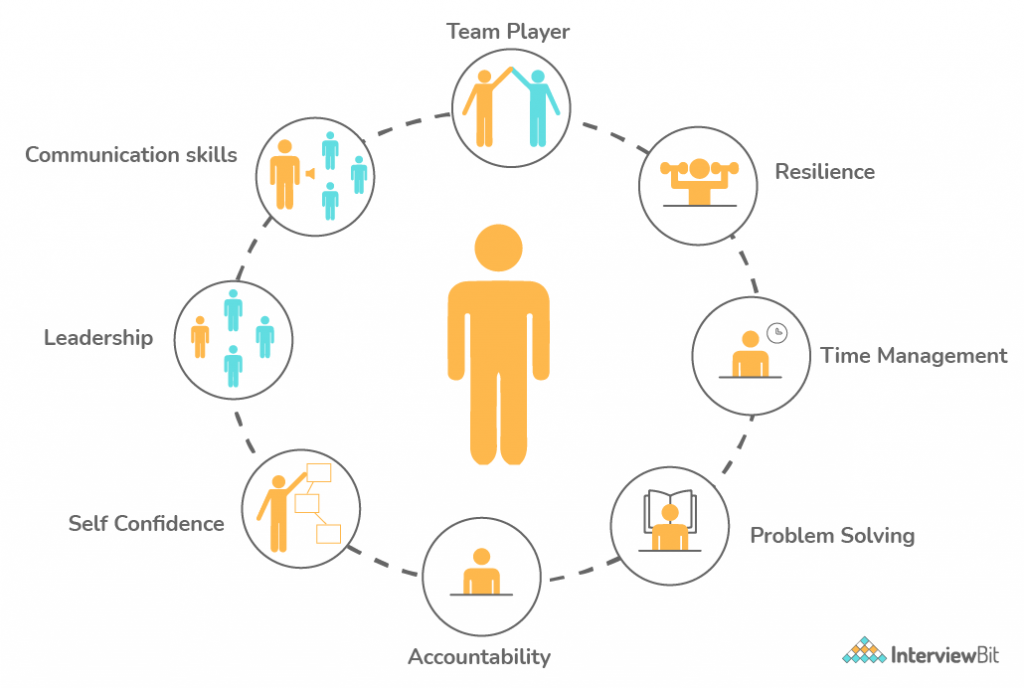
As a full-stack developer, you have to manage so many roles simultaneously. For this, besides hard skills, you have to be proficient in many of the soft skills as well. Some of them are:
- Communication
- Multi-Tasking
- Manages Time
- Inquisitive
- Team Player
- Effective Leader
- Patient
- Creative Mindset
- Attentive to Detail
Frequently Asked Questions
Here are the most frequently asked questions on Full Stack Developer.
1. Can I become a Full Stack Developer without any experience?
Ans: Yes, you can become a full-stack developer without any prior experience. However, your chances to stand out from the rest will be based on the number of skills you acquired like HTML, CSS, Python, Database Management System fundamentals, Ruby, Laravel, PHP, etc.
2. What do you need to know to become a full-stack developer?
Ans: To become a full-stack developer you need to have a proficient understanding of front-end development, back-end development, and databases. A full-stack developer is a part of the development team who understands all these three main elements of web development.
- For the front end, you need to have skills like HTML, CSS, JavaScript, etc., and Basic Designing skills.
- For the Back-end, you need to have basic knowledge of languages like python, PHP, Ruby, etc, and work with web protocols like HTTP, SOAP, etc., and architectural style REST.
- For Databases, have a proficient understanding of storage system servers like MySQL, Oracle, etc.
3. Which Full Stack is best?
Ans: MERN(MongoDB, Express, React, Node) Stack is commonly used by developers and companies these days. However, as a full-stack developer, you should keep knowledge of all different stacks like LAMP(Linux, Apache, MySQL, and PHP.) Stack, Django Stack etc, as every company has different demands and priorities.
4. Is a full-stack developer a good career?
Ans: Yes, a full-stack developer is a good career choice if you are into handling the front-end as well as the back-end of the product application. More and more employers in present times are willing to hire such proficient workers with multiple skill sets. The career scope of a full-stack developer is lined with learning and growth opportunities.
5. How long does it take to become a full-stack developer?
Ans: A minimum of 3-6 months is required to acquire a basic understanding of full-stack development. Although, the period of learning is never set in stone, therefore, it depends on your learning capacity and inquisitiveness to upskilling.
6. Is a full-stack developer in demand?
Ans: Yes, full-stack development is quite in demand for its diversified role and proficiency in different skill sets.
7. What is the full-stack developer’s salary?
Ans: A full-stack developer’s salary in India is approximate ₹582,659/year. The average pay of a full-stack developer in India is based on many factors including experience, location, employer, and skillset, and therefore could range from ₹1400k/yr to 300K/yr.


